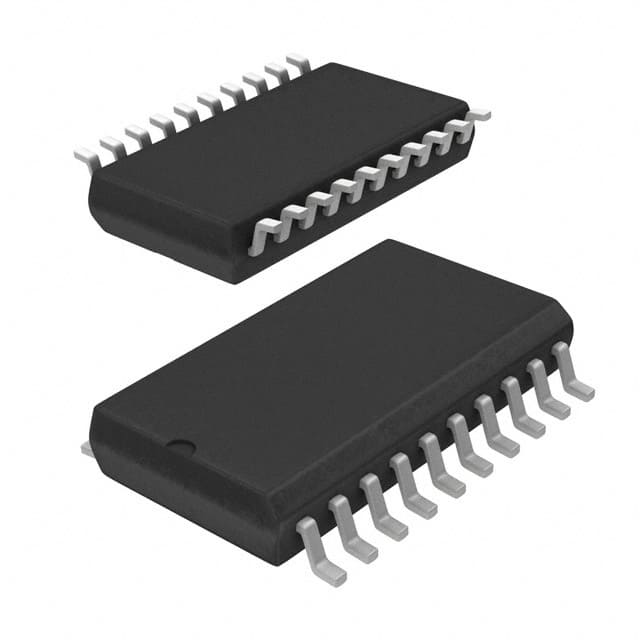Voir les spécifications pour les détails du produit.

Encyclopedia Entry: 74AC299SJ
Product Overview
Category
The 74AC299SJ belongs to the category of integrated circuits (ICs) and specifically falls under the family of flip-flops.
Use
This IC is primarily used for storing and transferring data in digital systems. It can be employed in various applications where sequential logic is required, such as in microprocessors, memory units, and communication systems.
Characteristics
- The 74AC299SJ is a 8-bit universal shift/storage register.
- It operates on a supply voltage range of 2V to 6V.
- This IC offers high-speed operation with a maximum clock frequency of 125 MHz.
- It features both parallel and serial data inputs and outputs.
- The device is designed to work within a wide temperature range, typically from -40°C to 85°C.
Package and Quantity
The 74AC299SJ is available in a standard 20-pin small-outline package (SOP). It is commonly sold in reels or tubes containing multiple units, with quantities varying depending on the supplier.
Specifications
- Supply Voltage Range: 2V to 6V
- Maximum Clock Frequency: 125 MHz
- Number of Pins: 20
- Operating Temperature Range: -40°C to 85°C
- Logic Family: AC
Pin Configuration
The pin configuration of the 74AC299SJ is as follows:
┌───┐
D0 ─┤1 20├─ VCC
D1 ─┤2 19├─ Q7
D2 ─┤3 18├─ Q6
D3 ─┤4 17├─ Q5
D4 ─┤5 16├─ Q4
D5 ─┤6 15├─ Q3
D6 ─┤7 14├─ Q2
D7 ─┤8 13├─ Q1
GND ─┤9 12├─ Q0
CP ─┤10 11├─ DS
└───┘
Functional Features
- The 74AC299SJ can operate in parallel load mode, shift-right mode, or hold mode.
- It has a clock input (CP) for synchronizing the data transfer.
- The device supports both serial and parallel data transfers.
- It offers asynchronous clear functionality to reset the register.
Advantages and Disadvantages
Advantages: - High-speed operation allows for efficient data handling. - Versatile functionality with multiple operating modes. - Wide temperature range enables usage in various environments.
Disadvantages: - Limited voltage supply range of 2V to 6V. - Requires careful consideration of clock frequency for optimal performance.
Working Principles
The 74AC299SJ operates based on the principles of sequential logic. It utilizes flip-flops to store and transfer data. The clock input synchronizes the data transfer, while the control inputs determine the operating mode. The IC's internal circuitry ensures reliable and accurate data storage and manipulation.
Application Field Plans
The 74AC299SJ finds applications in various digital systems, including: - Microprocessors and microcontrollers - Memory units and registers - Communication systems and protocols - Data storage and retrieval systems
Alternative Models
Other alternative models that offer similar functionality to the 74AC299SJ include: - 74HC299: A CMOS version with a wider voltage supply range. - 74LS299: A low-power TTL version with slower operation but lower power consumption. - 74F299: A faster version with higher operating frequency.
In conclusion, the 74AC299SJ is a versatile and high-speed 8-bit universal shift/storage register IC. Its wide range of applications and reliable performance make it a valuable component in various digital systems.
Word Count: 511
Énumérez 10 questions et réponses courantes liées à l'application de 74AC299SJ dans les solutions techniques
Sure! Here are 10 common questions and answers related to the application of 74AC299SJ in technical solutions:
Q: What is the purpose of the 74AC299SJ? A: The 74AC299SJ is an 8-bit universal shift/storage register used for data storage, parallel-to-serial or serial-to-parallel conversion, and general-purpose shifting operations.
Q: What is the maximum clock frequency supported by the 74AC299SJ? A: The 74AC299SJ can operate at a maximum clock frequency of 125 MHz.
Q: How many input/output pins does the 74AC299SJ have? A: The 74AC299SJ has a total of 20 pins, including 8 input/output pins, control pins, and power supply pins.
Q: Can the 74AC299SJ be cascaded to increase the number of bits? A: Yes, multiple 74AC299SJ registers can be cascaded together to increase the number of bits for larger data storage or shifting operations.
Q: What is the power supply voltage range for the 74AC299SJ? A: The 74AC299SJ operates with a power supply voltage range of 2V to 6V.
Q: Does the 74AC299SJ support tri-state outputs? A: Yes, the 74AC299SJ has tri-state outputs that allow for bus sharing and easy interfacing with other devices.
Q: Can the 74AC299SJ be used in both synchronous and asynchronous modes? A: Yes, the 74AC299SJ can be operated in either synchronous mode, where the shift operation is synchronized with the clock signal, or in asynchronous mode, where the shift operation occurs independently of the clock.
Q: What is the typical propagation delay of the 74AC299SJ? A: The typical propagation delay of the 74AC299SJ is around 5 ns, making it suitable for high-speed applications.
Q: Does the 74AC299SJ have built-in protection against electrostatic discharge (ESD)? A: Yes, the 74AC299SJ is designed with built-in ESD protection to ensure reliable operation in environments prone to electrostatic discharge.
Q: What are some common applications of the 74AC299SJ? A: The 74AC299SJ is commonly used in applications such as data storage, parallel-to-serial or serial-to-parallel conversion, shift registers, address decoding, and general-purpose digital logic circuits.
Please note that these answers are general and may vary depending on specific datasheet specifications and application requirements.

